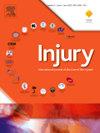Reexamining the need for antibiotic prophylaxis in pediatric upper extremity surgery
IF 2.2
3区 医学
Q3 CRITICAL CARE MEDICINE
Injury-International Journal of the Care of the Injured
Pub Date : 2025-03-17
DOI:10.1016/j.injury.2025.112271
引用次数: 0
Abstract
Aims
The literature has recently questioned the routine use of prophylactic antibiotics in adults undergoing clean, upper extremities surgeries. Moreover, consensus remains elusive if antibiotic prophylaxis in upper extremity (UE) and hand pediatric procedures are necessary. Therefore, we aim to investigate whether antibiotic prophylaxis has no effect on reducing postoperative surgical site infection (SSI) rates in pediatric upper extremity (UE) procedures.
Methods
A retrospective review of all pediatric patients undergoing clean UE surgery between November 2021 and November 2023 at a single institution was performed. Primary outcome measures were diagnosis of SSI by 14-days and 30-days. Secondary outcomes included the type of management employed to treat infection, including the use of antibiotics only, operative washout and hardware removal. Chi-square and Fisher's exact tests were performed for categorical variables, and Wilcoxon rank-sum tests were performed for continuous variables. A p-value of < 0.05 for all analyses was considered statistically significant.
Results
396 patients (150 female and 246 male) were included for analysis- 217 received preoperative antibiotics and 179 did not. Among those who received preoperative antibiotics, only two patients were diagnosed with an SSI, with an infection rate of 0.9 %. Similarly, in those who did not receive preoperative antibiotics, two patients were diagnosed with an SSI, with an infection rate of 1.1 %. Infection rates were not statistically different (p = 0.846). The odds ratio (OR) of having an SSI when not receiving preoperative antibiotics is 1.21 (95 % CI: 0.16 – 8.71).
Conclusion
The study challenges the historical dogma of the necessity of preoperative antibiotics in pediatric upper extremity surgeries. The findings suggest that there is no statistical difference in postoperative SSI rates whether antibiotic prophylaxis is administered. To reassess the necessity of preoperative antibiotics in upper extremity cases, further randomized controlled studies with larger patient populations should be advocated for.
求助全文
约1分钟内获得全文
求助全文
来源期刊
CiteScore
4.00
自引率
8.00%
发文量
699
审稿时长
96 days
期刊介绍:
Injury was founded in 1969 and is an international journal dealing with all aspects of trauma care and accident surgery. Our primary aim is to facilitate the exchange of ideas, techniques and information among all members of the trauma team.

 求助内容:
求助内容: 应助结果提醒方式:
应助结果提醒方式:


